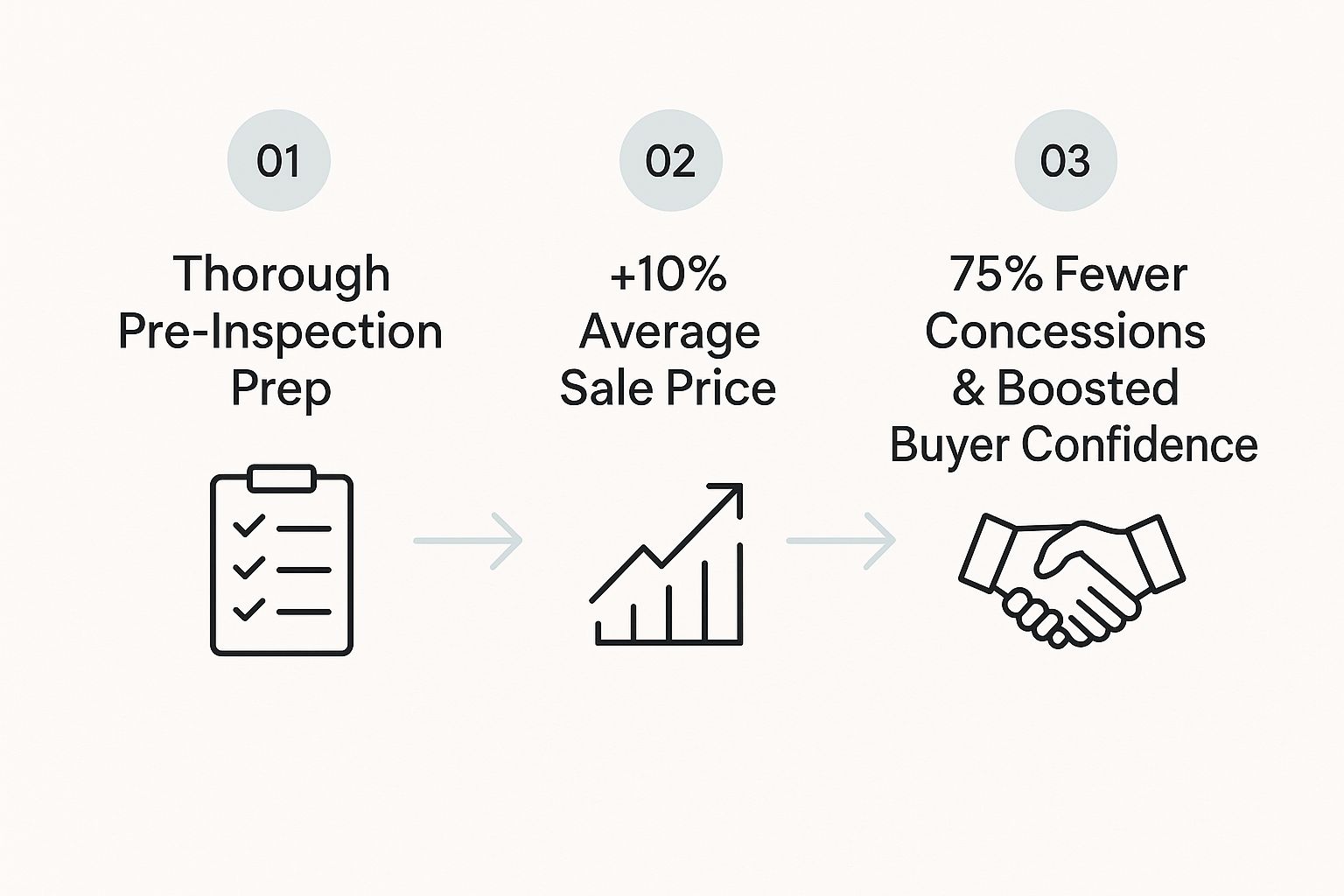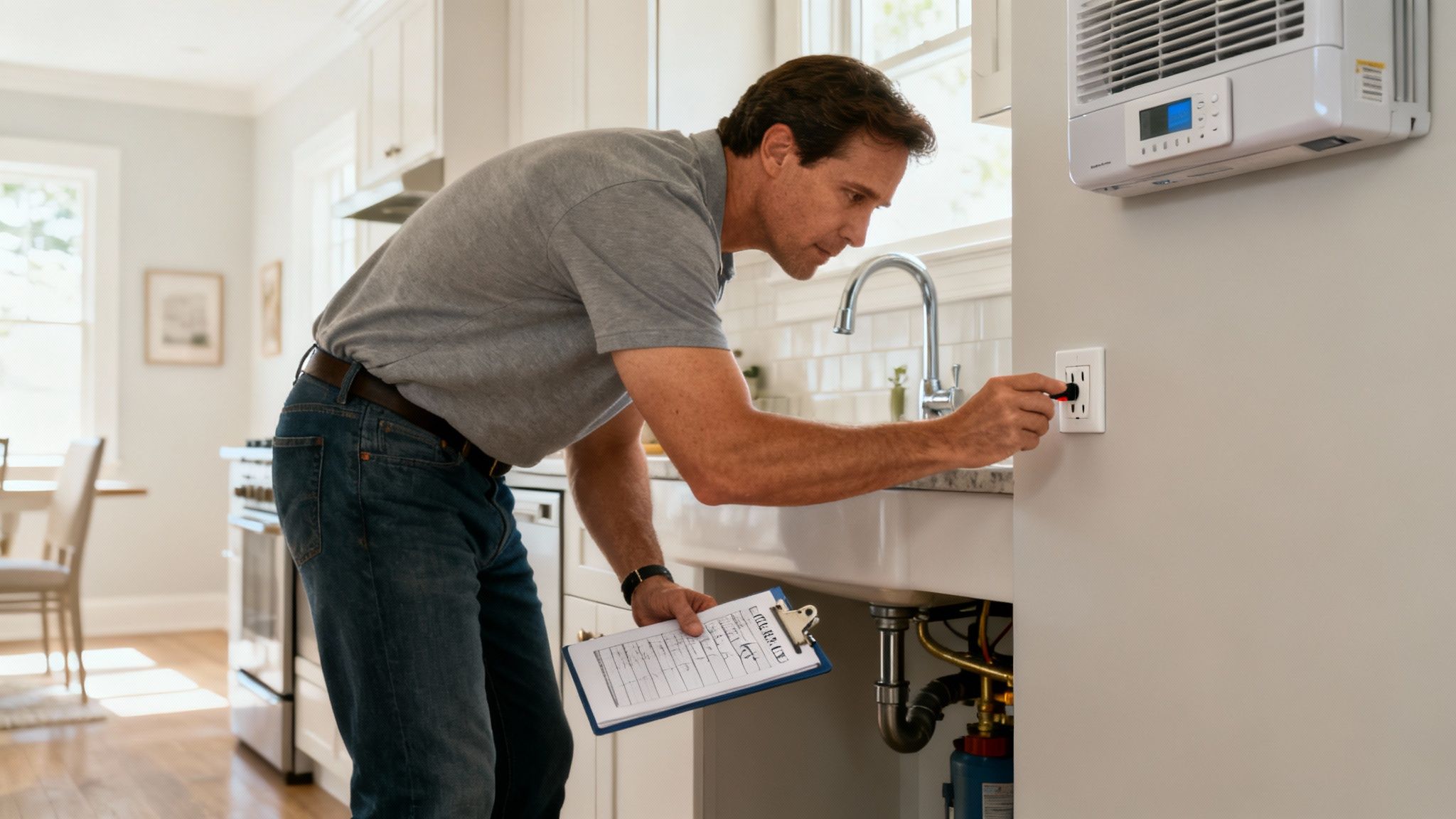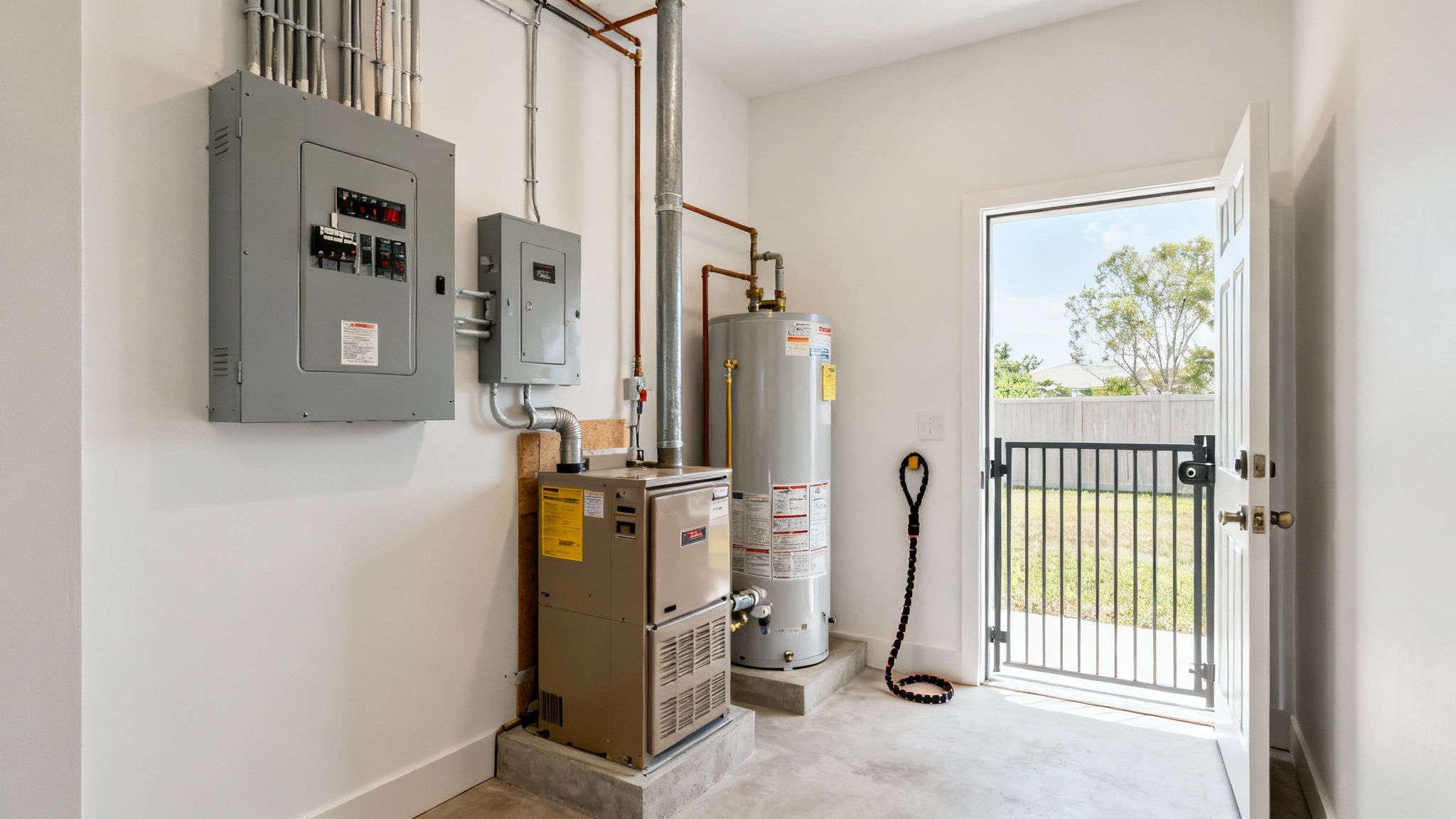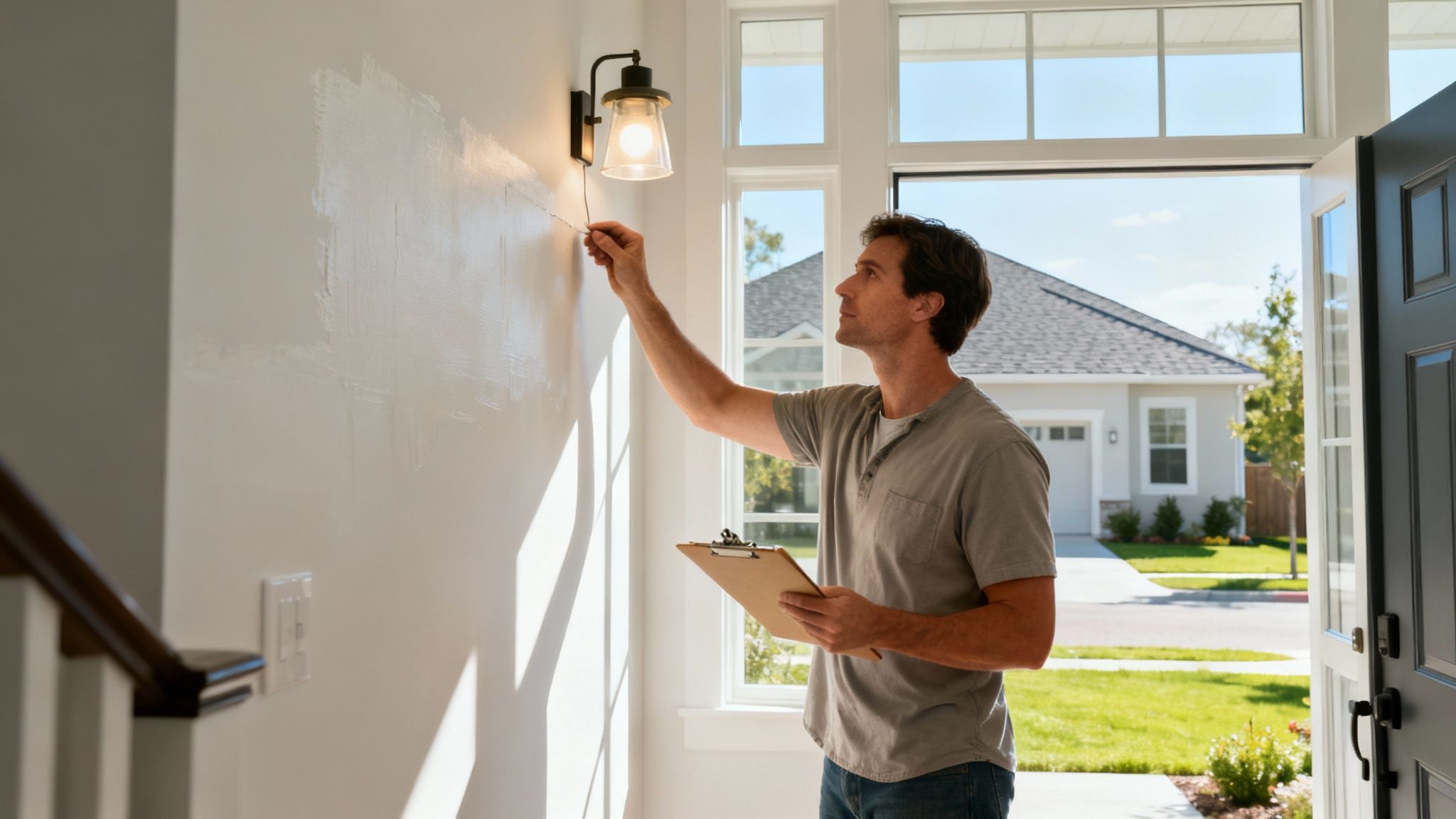How to Prepare for a Home Inspection A Seller Guide
When you're getting ready for a home inspection, it really comes down to one thing: taking care of the small stuff before it can turn into a big headache during negotiations. The whole point is to make sure the inspector can get to everything easily, to double-check your core systems like plumbing and electrical, and to present a home that says "well-cared-for." That first impression builds a ton of buyer confidence.
Why Your Home Inspection Prep Is a Game Changer
In the world of real estate, a home inspection is more than just a routine check-up. It's a make-or-break moment that can define the final outcome of your sale. A lot of sellers get stressed out just thinking about it, but the smart ones see it as a golden opportunity. Preparing your home isn't about trying to hide problems—it's about highlighting its true value and showing you've taken pride in ownership.
When you take this strategic approach, you're not just reacting; you're taking control of the narrative. By fixing minor issues ahead of time, you stop those little things from blowing up into deal-breakers or giving the buyer an opening to chip away at your price.
Building Buyer Confidence
Think about it from the buyer's perspective. A home that's ready for inspection sends a strong, clear message: this property has been loved and maintained. It tells them they probably won't find any nasty surprises lurking behind the walls. That sense of confidence is priceless and almost always leads to a much smoother, faster closing.
This infographic breaks down how that prep work directly translates into a better sale.

As you can see, spending a little time on these tasks beforehand can seriously boost your final sale price and cut down on the concessions you might have to make.
Remember, your goal isn't to pretend the home is "perfect"—because no home is. The real goal is to present a well-maintained, transparent property that makes the buyer feel secure about their investment.
The Financial Impact of Preparation
The numbers don't lie. Sellers who get their homes inspection-ready almost always deal with fewer repair requests. That directly translates to keeping more of your hard-earned equity.
We're even seeing a major shift in the market toward pre-listing inspections, with some experts projecting a 20-30% growth in demand for them. Sellers are doing this to get ahead of any issues and offer total transparency. It makes sense when you consider that a whopping 86% of typical inspections uncover at least one problem. For nearly 20% of homes, those problems are with the roof or electrical systems. You can dig into more home inspection forecasts and what they reveal to see the trends.
At the end of the day, a few hours of work now can save you from losing thousands of dollars at the negotiation table and help lock in a more profitable sale.
To make this even easier, here's a quick cheat sheet for where to focus your energy before the inspector arrives.
Home Inspection Prep At a Glance
| Access & Clearances | Ensure the inspector can reach all critical areas safely and easily. | Clear clutter around the furnace, water heater, and electrical panel. |
| Basic Maintenance | Address obvious, minor issues that signal neglect. | Replace all burnt-out light bulbs and check smoke detector batteries. |
| Plumbing & Water | Prevent easy-to-spot leaks from becoming a negotiation point. | Run faucets and check under all sinks for drips. Fix any leaky toilets. |
| Systems & Appliances | Confirm all major systems are operational for testing. | Make sure all pilot lights are on for fireplaces and water heaters. |
| Exterior & Grounds | Show that the home's exterior has been properly maintained. | Clean out gutters and ensure downspouts direct water away from the foundation. |
This table isn't exhaustive, but tackling these five areas will put you miles ahead of the game and show your home in its best possible light.
Your Essential Interior Inspection Checklist

When an inspector steps inside your home, they begin a methodical hunt for issues with the property’s most critical systems. This is where small, easily overlooked details can suddenly become major sticking points in negotiations. Your goal is to get ahead of these things, show the home has been well-maintained, and keep that final report as clean as possible.
Try to see your home through the inspector's eyes. A burnt-out lightbulb isn't just a bulb to them—it's a question mark. Is it the bulb, the fixture, or a deeper electrical problem? Swapping it out beforehand erases that doubt completely.
By tackling these smaller items, you keep the focus on your home's value and best features, not on a laundry list of potential repairs.
Plumbing and Water Systems
When it’s not where it's supposed to be, water is a home’s worst enemy. Inspectors are hardwired to spot any sign of moisture damage, whether it’s a fresh drip or an old stain. That faint water mark under the bathroom sink might be ancient history to you, but to a buyer, it’s a red flag for hidden mold or a recurring leak.
Your first move should be to check every single water source in the house.
- Look for Leaks: Get on your hands and knees and check under every sink while the water is running. Look around the base of each toilet for any sign of moisture. A tiny, slow drip is one of the most common—and easily fixable—defects we see.
- Test for Slow Drains: Turn on every faucet and showerhead. If the water backs up, you’ve likely got a clog that needs to be addressed before the inspector finds it.
- Flush Every Toilet: Make sure each toilet flushes properly and, just as importantly, stops running once the tank is full. A constantly running toilet is a waste of water and an easy fix.
Taking care of these little plumbing issues is one of the smartest things you can do to prepare. It's also just good practice, something we cover in more detail in our home maintenance tips for new homeowners guide.
Electrical and Safety Components
Right after water, an inspector’s focus will shift to the electrical system. They'll test a random sampling of outlets, switches, and fixtures to ensure everything is safe and functioning correctly. Your prep work here is simple but absolutely essential.
Start with a full sweep of the house, flipping every single light switch. Replace any burnt-out bulbs you find, from the living room chandelier to the forgotten one in the back of the hall closet. This one tiny task prevents the inspector from wondering if the problem is a $2 bulb or a $200 wiring issue.
Next, move on to the critical safety devices.
- Test GFCI Outlets: Go to every Ground Fault Circuit Interrupter outlet—those outlets with the little buttons, usually in kitchens, bathrooms, and garages. Push the "TEST" button to make sure it kills the power, then hit "RESET" to bring it back.
- Check Smoke & CO Detectors: Press the test button on every smoke and carbon monoxide detector in the house. If one chirps with a low battery, replace it on the spot.
A non-functional safety device isn't just a note on a report; it's a real-life hazard. Making sure these are all in perfect working order is non-negotiable and shows you're serious about the home's safety.
HVAC and Major Appliances
Finally, the inspector will turn their attention to your home's mechanical workhorses. The heating, ventilation, and air conditioning (HVAC) system is a big-ticket item they'll definitely test. Make sure it properly kicks on for both heat and air conditioning when controlled from the thermostat.
Here’s a simple task with a big impact: replace the furnace filter. A filthy, clogged filter screams "deferred maintenance" and makes the entire system work harder than it should.
Don’t forget the appliances. If the dishwasher, stove, or garbage disposal are part of the sale, make sure they all work. The inspector will run a quick wash cycle and test the stove burners. These are standard checks, so you want to be certain everything is ready to go.
Mastering Your Curb Appeal and Structural Health

The inspection starts the moment the inspector pulls up to the curb. Before they’ve even stepped out of their car, they’re already forming a first impression. A home that looks sharp and cared for on the outside sends a powerful message: the inside has likely received the same level of attention.
On the flip side, things like peeling paint, cracked walkways, or overflowing gutters can immediately set a negative tone. These might seem like small cosmetic flaws, but to an inspector, they can signal a pattern of deferred maintenance, putting them on high alert for bigger, hidden problems. The goal here is to present a property that looks and feels solid from the get-go.
Your Roofline and Drainage System
An inspector's eyes almost always go upward first, looking at the roof—your home’s main defense against the elements. They'll be scanning for any obvious red flags like missing or curled shingles, moss growth, or other signs of significant wear. You don't necessarily need a brand-new roof, but addressing the small, visible issues can make a world of difference.
Just as critical is the drainage system. We see clogged gutters on inspection reports all the time, and it’s a major red flag because it can lead to some seriously expensive water damage down the road.
- Get those gutters clean. Pull out all the leaves, twigs, and other gunk. A clean gutter is an easy way to show you’re on top of basic home maintenance.
- Check the downspouts. Make sure they’re properly attached and channeling water at least three to five feet away from your foundation. Puddles forming near the house are a huge concern for any inspector.
- Trim back overhanging branches. Any limbs touching or hanging directly over the roof need to go. This not only prevents damage but also cuts off a direct highway for pests into your attic.
Taking care of these few things is a clear sign of responsible ownership and goes a long way in protecting your home’s structure.
A well-maintained exterior isn't just about looking good; it's about proving your home is safe, dry, and structurally sound. Every small fix you make on the outside helps build a case for the property's overall health.
Siding, Windows, and Foundation
Next, the inspector will do a full walk-around of the property, taking a close look at the siding, windows, and foundation. What are they looking for? Cracks, rot, and any sign that water is getting in where it shouldn’t. Being proactive here can save you from a long list of minor dings on the report that can collectively worry a potential buyer.
It’s worth noting that buyers are paying more attention than ever to a home’s condition, with requests for home inspections climbing by about 17.5% recently. Gutter issues and window-related problems are some of the most common exterior complaints, showing up in over 10% and 18% of reports, respectively. You can discover more insights about current housing market trends on Bentley Home Inspection.
Here’s a simple checklist to run through for your home's exterior envelope:
- Seal up any gaps. Grab a tube of caulk and fill in cracks around window and door frames, as well as where any utility lines enter the house. This is a quick fix that stops drafts and moisture.
- Inspect your siding. Look for any warped boards, loose panels, or areas where paint is chipping away. A quick paint touch-up is one of the easiest ways to boost your home’s visual appeal.
- Examine the foundation. Check for any visible cracks. While tiny hairline cracks are usually nothing to worry about, any larger, more significant ones should be looked at by a professional.
Investing a little time in these areas shows that you’ve cared for the home from top to bottom. Our guide to proactive maintenance solutions offers even more detail on how you can get ahead of these common inspection finds.
Setting the Stage for a Flawless Inspection Day

You’ve gone through every room and buttoned up the exterior, but there's one last piece to the puzzle. The success of an inspection often comes down to simple logistics. Creating a welcoming and accessible space for the inspector doesn't just make their job faster; it sets a professional, cooperative tone right from the start.
An inspector’s job is to be thorough. Anything that gets in their way can cause delays or, even worse, force them to mark an area as "uninspectable." That single phrase can scare a buyer and lead to needless follow-up appointments. Thinking ahead just a little bit can make all the difference.
Ensure Unobstructed Access to Key Areas
Inspectors need to get up close and personal with your home's most critical systems, and they can't do that if they're climbing over boxes and furniture. Trust me, no inspector wants to be the one to move your personal belongings and risk damaging something.
Before they arrive, make sure you’ve cleared a wide path to and around these essential components:
- Your Electrical Panel: They need to open the panel door fully to inspect the breakers and wiring.
- The Furnace or HVAC Unit: Aim for at least three feet of clear space all around the unit. This is a solid rule of thumb.
- The Water Heater: The inspector needs to be able to walk completely around it to check for leaks, corrosion, and proper installation.
- Attic and Crawl Space Entrances: If your attic hatch is in a closet, don't make them excavate a mountain of clothes or holiday decorations to get to it.
This simple step shows respect for the inspector's time and makes their job infinitely easier.
A home inspector’s time is limited. Providing clear, immediate access to all major systems means they can spend their time evaluating the home's condition, not moving your stuff. This small courtesy can make a significant difference in the smoothness of the inspection.
Prepare for a Smooth Walkthrough
Beyond just clearing pathways, a few other small details can turn a good inspection into a great one. Think of it like preparing for a very important guest—one who just happens to be carrying a flashlight and a checklist.
First thing's first: make sure all utilities are on. This is especially critical if the property is vacant. An inspector can't test the furnace, AC, hot water, or appliances if the gas, water, and electricity are off. It sounds obvious, but it's a surprisingly common mistake that can bring an inspection to a dead stop.
Next, do a quick sweep and take care of these small but important items:
- Unlock everything. This means all gates, sheds, electrical boxes, and doors to utility closets or crawl spaces.
- Leave out the remotes. Gather any remotes for garage doors, ceiling fans, or gas fireplaces and leave them in a highly visible spot, like the kitchen counter.
- Contain your pets. We know your dog is friendly, but even the best-behaved pet can be a distraction. It’s best to take them out for the day or secure them in a crate during the 2-4 hour inspection window.
By taking care of these simple logistics, you’re allowing the inspector to focus entirely on the home itself, which is exactly where you want their attention.
Thinking Like an Inspector: Modern Tools and Tactics
If you really want to sail through a home inspection, you have to get inside the inspector's head. It’s not just about a guy with a flashlight and a clipboard anymore. Today’s top inspectors show up with a whole arsenal of technology designed to spot problems the naked eye would completely miss.
When you know an inspector is bringing a thermal imaging camera, for instance, you stop just looking for obvious water stains. You start thinking about cold spots in the wall that could signal missing insulation or, worse, hidden moisture from a slow, nagging leak. That shift in perspective is everything.
The Modern Inspector's Toolkit
Inspectors use specific tools to find specific problems. Getting familiar with what’s in their bag is a huge advantage because it tells you exactly where they're going to focus.
- Thermal Imaging Cameras: These devices are incredible. They read heat signatures and display temperature differences on surfaces. An inspector will scan ceilings and walls to find cold spots that scream "water intrusion" or "insulation gap."
- Drones: Got a steep or complex roof? Forget the ladder. A drone gives a safe, super-detailed view of every shingle, bit of flashing, and gutter. They can spot cracked tiles or failing seals from angles you'd never get from the ground.
- Moisture Meters: These are small, handheld tools with two little prongs. An inspector will press them into drywall or wood to measure moisture content. It's the perfect way to confirm if that faint stain is an old, dry issue or a five-alarm active leak.
This tech isn’t meant to scare you; it’s just about giving the buyer the most accurate picture of the home's health. The inspection industry is quickly adopting tools like these, plus things like digital reporting and 3D mapping, because buyers demand total transparency. You can learn more about how the inspection industry is gearing up for the future on AHIT.com.
To help you get ahead, we’ve put together a quick cheat sheet of common issues these tools uncover and what you can do about them before the inspector shows up.
Common Inspection Issues and Proactive Solutions
| Hidden Water Intrusion | Indicates potential mold, rot, or an active leak. Thermal cameras are great at spotting these temperature anomalies. | Check under sinks and around toilets for any dampness. Look for discoloration on ceilings, especially below bathrooms or attics. |
| Faulty Electrical Outlets | A fire hazard. Inspectors use testers to check for proper grounding and polarity. | Use a simple outlet tester (available at any hardware store) to check key outlets in the kitchen, bathrooms, and garage. Fix any that are open-ground or have reversed polarity. |
| Poor Attic Ventilation | Can lead to moisture buildup, mold, and ice dams in the winter. Inspectors look for blocked soffit vents and adequate exhaust. | Head up to your attic and make sure insulation isn't blocking the vents at the eaves. Ensure gable or ridge vents are clear of debris. |
| Minor Roof Damage | Small issues like a cracked shingle or loose flashing can turn into big leaks. Drones make these easy to spot. | Do a visual scan from the ground with binoculars. If it's safe, clean your gutters and look for excessive granules, which can signal aging shingles. |
Taking these small steps shows you’ve been diligent, which builds a lot of trust with both the inspector and the potential buyer.
What This Means for Your Preparation
Thinking like an inspector is about treating the cause, not just the symptom. Don't just slap a coat of paint over a water stain. You need to dig in and find out where it came from—a leaky pipe, a clogged gutter, or poor ventilation—and fix that.
By understanding the "why" behind an inspector's methods, you can transform your preparation from a reactive chore into a proactive strategy. You're not just tidying up; you're confirming the health of your home’s core systems before they're ever questioned.
Knowing a drone might fly over your roof, for example, pushes you to do more than just clean the gutters. It gets you looking for that one piece of loose flashing around the chimney—the exact kind of detail a high-res aerial photo will catch in a heartbeat. This proactive mindset is what separates a good inspection from a great one, leaving you with fewer surprises and a much smoother path to closing.
Common Questions About Preparing for an Inspection
Even after you've checked every box on your prep list, it’s completely normal to have some last-minute questions as inspection day gets closer. This is often the final hurdle before the finish line, and knowing what to expect can really help calm the nerves. Let's tackle some of the most common things we hear from sellers.
Should I Be at the House During the Home Inspection?
It's a common question, but the answer from most real estate pros is a firm "no." It’s almost always better for sellers to step out during the inspection.
This gives the buyer and their inspector the space they need to do a thorough job and discuss their findings openly. Without the homeowner present, they won't feel rushed or like they're being rude by pointing out flaws. Your absence signals that you trust the process, which can set a much better tone for everything that follows.
Plan on being away from the house for about 2 to 4 hours. Let your real estate agent be the point of contact—they know how to handle the communication and will keep you in the loop.
What if the Inspector Finds a Big Problem I Didn’t Know About?
First thing's first: don't panic. This is literally what home inspections are for—to uncover the unknown. Finding a major issue doesn't automatically kill the deal.
The inspection report is a starting point for negotiation, not a final judgment. An unexpected issue simply opens a conversation about how to move forward fairly.
This is where a good agent earns their commission. They’ll help you figure out the best way forward. Your options usually include:
- Offering to get the repair done by a qualified professional before closing.
- Providing a credit to the buyer at closing so they can handle the repair themselves.
- Negotiating a lower sale price to account for the cost of the fix.
Am I Required to Fix Everything on the Report?
Absolutely not. The report isn't a mandatory to-do list handed to the seller. Think of it as an evaluation of the home's current condition.
Negotiations almost always focus on significant health, safety, or functional problems. We're talking about major systems like the roof, HVAC, plumbing, electrical, or foundation. Minor cosmetic flaws or normal wear-and-tear are rarely on the table. Of course, what's considered "major" can depend on your specific purchase agreement and what's standard in your local market.
If you’re a landlord, you might notice some overlap between an inspector's findings and standard rental requirements. For a deeper dive, you can look at our property inspection checklist for landlords to see how those standards compare.
Is It Worth Getting a Pre-Listing Inspection?
A pre-listing inspection can be a fantastic strategic move. It puts you in the driver's seat. You get to find and fix any issues on your own timeline and budget, which prevents those eleventh-hour surprises that can derail a sale.
Showing up with a clean, pre-inspected report builds a huge amount of trust with potential buyers. It can help justify your asking price and often leads to a much faster, smoother sale with far fewer headaches.
At Northpoint Construction, we know that getting a home ready for the market can feel like a monumental task. Whether you need to knock out a list of pre-inspection repairs or are thinking about a bigger remodel to boost your home’s value, our team is ready to help. We’re experts at turning construction challenges into beautiful, finished projects.
Learn more about our home remodeling and repair services at buildnp.com

